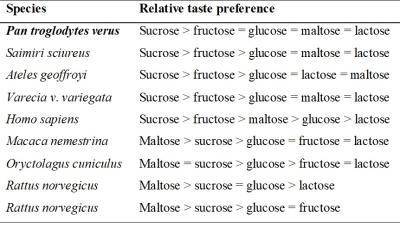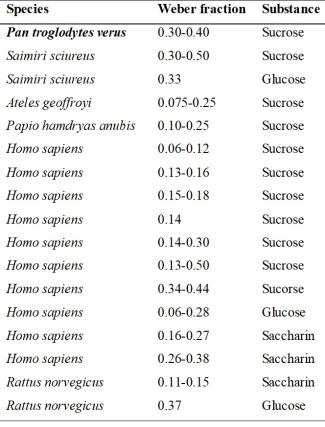Discussion
I demonstrated that the order of relative sweetness of the five carbohydrates tested here which the chimpanzees displayed was similar across the different concentrations tested: sucrose > fructose > glucose = maltose = lactose. In the taste difference threshold test, the chimpanzees as a group were found to have a Weber fraction of 0.3 (at 100 mM) and 0.4 (at 200 mM), respectively, for sucrose.
Relative taste preference

The order of relative preferences for food-associated carbohydrates found in the present study corresponds to findings in previous studies with squirrel monkeys, spider monkeys, black-and-white ruffed lemurs, and also with studies on relative sweetness in humans.
Studies on relative taste preferences for carbohydrates in rats, rabbits and in macaques differ markedly from findings in other primates tested so far, where rats, rabbits and macaques have been found to prefer maltose over sucrose.
Macaques (genus Macaca) include a large proportion of plants into their diet which contain a high amount of starch (MacKinnon and MacKinnon 1980), whereas chimpanzees largely feed on fruits containing the three quantitatively predominant soluble carbohydrates sucrose, fructose and glucose. The reason for this markedly different pattern of preference is that rats and rabbits are known, and macaques are believed to have additional taste receptors for starch-derived poly- and oligosaccharides, which can bind maltose, but not sucrose.
Studies conducted on the order carnivora showed that, for example, the lesser panda (Ailurus fulgens) prefers sucrose, glucose, maltose and lactose but not fructose over tap water, in a two-bowl preference test. The Haussa genet (Genetta thieryi) and the meerkat (Suricata suricatta) prefer sucrose, glucose, maltose but not fructose and lactose over tap water, and dogs (Canis domesticus) prefer sucrose, fructose, glucose, lactose but not maltose over tap water. Species from the Felidae family, such as the domestic cat (Felis silvestris catus) and the Asiatic lion (Panthera leo), in contrast, are indifferent towards sugars. Genetic studies have shown that felids are lacking the gene coding for a functional sweet-taste receptor. Considering their carnivorous diet this fits to the notion that the taste perception of a given species mirrors an evolutionary adaptation to its dietary specialization.
Taste difference threshold

Several studies have determined human taste difference threshold for sucrose, with Weber fractions ranging from 0.06-0.50. However, only few studies so far assessed taste difference thresholds for sucrose in other species, including primates. Squirrel monkeys (Saimiri sciureus) had a Weber fraction of 0.3 for sucrose, at the two reference concentrations of 100 and 200 mM. The Weber fraction for sucrose in spider monkeys (Ateles geoffroyi) and olive baboons (Papio hamdryas anubis) was 0.2 for both species at a reference concentration of 100 mM, and 0.25 and 0.2, respectively, at a reference concentration of 200 mM. These values are similar to the Weber fractions reported in humans whereas the Weber fraction of the squirrel monkey is more similar to that of the chimpanzee. However, while the taste performance in humans has been assessed with sophisticated signal detection methods, animals such as rats, non-human primates as well as chimpanzees (in the present study) have been tested with a simple two-bottle preference test. It is commonly agreed that the former method is more sensitive than the latter, and therefore it is possible that species tested with the two-bottle preference test might have even lower values for the Weber fraction than the values that are known today.
Responsible for this page:
Director of undergraduate studies Biology
Last updated:
05/19/18
